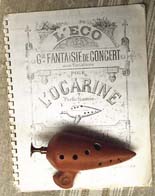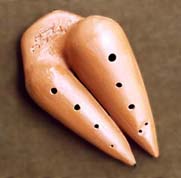The history of "concerto di ocarine"
The record seeks to revive and reprocess the performing quality of the famous ocarina groups of the late eighteen hundreds, early nineteen hundreds, a period in which the clay ocarina, which was probably invented by Giuseppe Donati of Budrio (Bo logna) underwent its golden age: hence the "Ocarina of Budrio".

Donati himself had formed a quintet of ocarinists which had already left enthusiastic memories of provincial concerts characterized by overwhelming successes by 1863 (suffice to think that the press of the period reported that the group was forced to repeat the programma twice a night due to calls for encore). On his death, the group was reformed by G. Grossi, who, changing the number of musicians from five to seve n, brought them to incredible success and to European, Russian and American tours.
When Grossi died, C. Testi became director and carried on the work of his predecessors energetically. However, it was the great A. Barattoni who injected a q ualitative improvement into the undertaking by renewing the already rich repertoire with numerous and beautiful original compositions for the ocarina and with very relevant concert work.
After this splendid period, with the first world war, the ocarina began a slow and relentless decline, especially from the qualitative point of view, up to the point of nowadays being a synonym of "out of tune".Original and period transcription pieces for a "Concert of Ocarinas"
The instruments
The instruments used on the record were handmade by G. Pacchioni in the traditional manner and are therefore, copies of master instruments of the budrian school of the late eighteenth century.
They are:
A concert of seven made up of:
| PRIMA IN DO |
(DO 4 LA 5) |
| SECONDA IN SOL |
(SO L 3-RE 4) |
| TERZA IN DO |
(DO 3-FA 4) |
| QUARTA IN SOL |
(SOL 2-DO 3) |
| QUINTA IN DO |
(DO 2-RE 2) |
| SESTA IN SOL |
(SOL1-LA2) |
| SETTIMA IN DO |
(DO l RE 2) |
Microcarina in C with six holes, barely 5.5 cm in length and with a range of one ninth (partially chromatic).
The instrument is tuned an octave above the 1st on C mentioned above.
A Double toned ocarina in twins thirds .
This extraordinary instrument is ideal to support or sustain a group of ocarinas and is made up of two chanters tuned to a third and which can be played together or independently.
Both of these unusual instruments are made with difficul ty because of their technical and physical characteristics and given the instability of the building material (clay).
 The manual construction technique avails of a simple wooden cone, wrapped in a 5-7 mm. thick clay paste, so as to create a closed cone with the characteristic cupola which is so handy for the player.
The manual construction technique avails of a simple wooden cone, wrapped in a 5-7 mm. thick clay paste, so as to create a closed cone with the characteristic cupola which is so handy for the player.
The fitting of the whistle completes the assembly, which is foll owed simultaneously by the drying process and the intonation and optimization of the air passage procedures, producing the characteristic clean, gay and pure sound of this instrument.
index
